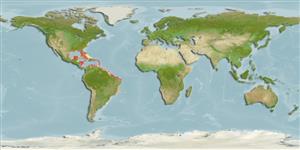Common names from other countries
Environment: milieu / climate zone / depth range / distribution range
Ecologie
; diepteverspreiding 6 - 20 m (Ref. 104365). Tropical
Western Atlantic: USA to Brazil.
Length at first maturity / Size / Gewicht / Leeftijd
Maturity: Lm ? range ? - ? cmCommon length : 6.5 cm TL mannelijk/geslacht niet bekend; (Ref. 344)
Shell wedge-shaped, heavy, moderately inflated, with rhomboidal outline. Shell surface smooth. Posterodorsal slope somewhat flat. Pallial sinus large. Hinge with 2 lateral teeth (1 bifid) on each valve, lateral teeth absent. Umbones slightly posterior. Periostracum thin, glossy. Colour: tan cream with purple umbonal region; periostracum brown (Ref. 344).
It has a total length of 6.5 cm (Ref. 344). Combination depth range: min from literature, max from estimate. It is found infaunal in shallow sandy bottoms (Ref. 344). Infaunal (Ref. 104365).
Life cycle and mating behavior
Geslachtsrijpheid | Voortplanting | Kuitschieten | Eieren | Fecundity | Larven
Members of the class Bivalvia are mostly gonochoric, some are protandric hermaphrodites. Life cycle: Embryos develop into free-swimming trocophore larvae, succeeded by the bivalve veliger, resembling a miniature clam.
Leal, J.H. 2003. (Ref. 344)
Status op de Rode Lijst van het IUCN (Ref. 130435)
Status bij CITES (Ref. 108899)
Not Evaluated
Not Evaluated
Gebruik door de mens
Visserij: commercieel
| FishSource |
Tools
Meer informatie
Leeftijd/GrootteGroeiLengte-gewicht parametersLengte-lengte parametersMorfologieLarvenAbundantie
Internet-bronnen
Estimates based on models
Prijsklasse
Unknown.
